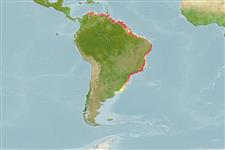>
Eupercaria/misc (Various families in series Eupercaria) >
Sciaenidae (Drums or croakers)
Etymology: Cynoscion: Greek, kyon = dog + Greek, odous = teeth + Greek, skion, skiaina = barbel, red mullet (Ref. 45335).
More on author: Lacepède.
Environment: milieu / climate zone / depth range / distribution range
Ökologie
seewasser; süßwasser; brackwasser demersal; ozeanodrom (Ref. 51243); tiefenbereich 1 - 20 m (Ref. 3702). Subtropical; 13°N - 40°S, 80°W - 34°W
Western Atlantic: Panama to Argentina; Southwest Atlantic: Sergipe, Brazil (Ref. 118626).
Length at first maturity / Size / Gewicht / Alter
Maturity: Lm 42.7 range ? - ? cm
Max length : 110 cm TL Männchen/unbestimmt; (Ref. 40637); common length : 45.0 cm TL Männchen/unbestimmt; (Ref. 3702); max. veröff. Gewicht: 17.0 kg (Ref. 40637)
Rückenflossenstacheln (insgesamt) : 11; Rückenflossenweichstrahlen (insgesamt) : 17 - 22; Afterflossenstacheln: 2; Afterflossenweichstrahlen: 7 - 9. Body nearly uniform silvery, dark greenish above. Without conspicuous spots on side but with diffuse dark areas along base of dorsal fin and on margin of spinous dorsal fin, ventral side of head, lower margin of pectoral, pelvic, and caudal fins often yellowish orange. Inside of opercle dusky. Mouth large, oblique. Lower jaw slightly projecting. Upper jaw with a pair of large canine-like teeth at tip. Lower jaw with a row of enlarged inner-row teeth, gradually increasing in size posteriorly. Chin without barbels or pores. Snout with 2 marginal pores. Pectoral fins about equal in length to pelvic fins. Gas bladder with a pair of long, straight, horn-like appendages. Sagitta earstone thin and elongate. Soft portion of dorsal fin unscaled except 2 or 3 rows of small scales along its base (Ref 51271).
Forms schools (Ref. 35237). Found over mud or sandy mud bottoms near mouths of rivers. Juveniles are restricted to brackish and fresh waters. Feeds on shrimps and fishes. Important food fish (Ref. 3702).
Life cycle and mating behavior
Geschlechtsreife | Fortpflanzung | Ablaichen | Eier | Fecundity | Larven
Chao, L.N., 1978. Sciaenidae. In W. Fischer (ed.) FAO species identification sheets for fishery purposes. West Atlantic (Fishing Area 31). Volume 4. FAO, Rome. (Ref. 3702)
IUCN Rote Liste Status (Ref. 130435: Version 2024-2)
Bedrohung für Menschen
Harmless
Nutzung durch Menschen
Fischereien: kommerziell; Sportfisch: ja; Aquarium: Kommerziell
Tools
Zusatzinformationen
Download XML
Internet Quellen
Estimates based on models
Preferred temperature (Ref.
123201): 22.5 - 28, mean 27.3 °C (based on 292 cells).
Phylogenetic diversity index (Ref.
82804): PD
50 = 0.5000 [Uniqueness, from 0.5 = low to 2.0 = high].
Bayesian length-weight: a=0.00741 (0.00476 - 0.01154), b=3.06 (2.94 - 3.18), in cm total length, based on LWR estimates for this species & Genus-body shape (Ref.
93245).
Trophic level (Ref.
69278): 4.1 ±0.70 se; based on food items.
Generation time: 4.1 ( na - na) years. Estimated as median ln(3)/K based on 1
growth studies.
Widerstandsfähigkeit (Ref.
120179): mittel, Verdopplung der Population dauert 1,4 - 4,4 Jahre. (K=0.27).
Prior r = 0.56, 95% CL = 0.37 - 0.84, Based on 3 data-limited stock assessments.
Fishing Vulnerability (Ref.
59153): Moderate to high vulnerability (45 of 100).
Nutrients (Ref.
124155): Calcium = 51.9 [30.0, 101.1] mg/100g; Iron = 0.842 [0.438, 1.547] mg/100g; Protein = 19.5 [18.0, 21.2] %; Omega3 = 0.291 [0.169, 0.485] g/100g; Selenium = 22.7 [11.9, 48.1] μg/100g; VitaminA = 7.48 [2.48, 25.80] μg/100g; Zinc = 0.614 [0.445, 0.913] mg/100g (wet weight); based on
nutrient studies.
